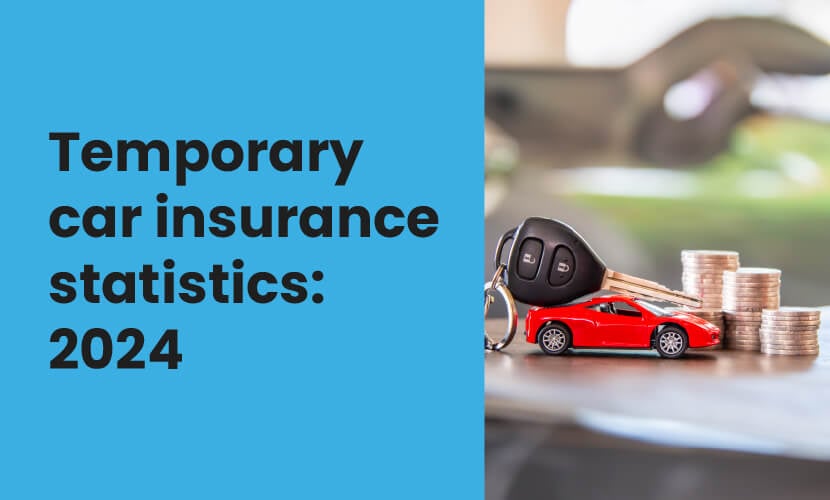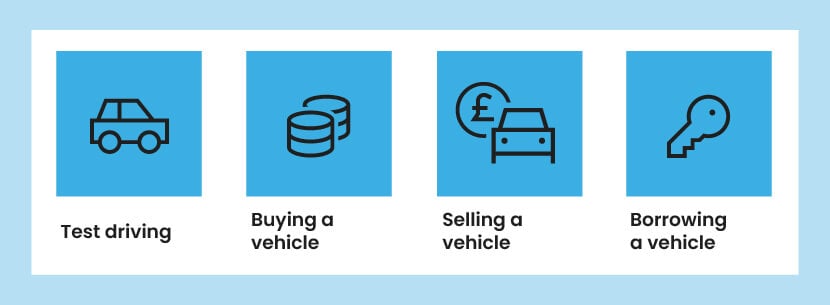Confused.com provided almost 5 million temporary car insurance quotes over 2023. We wanted to explore everything you need to know about temporary car insurance for 2024. Who uses it, why do they like it, and what does the average temporary cover cost?

Temporary car insurance key statistics overview:
- The most common reasons for buying temporary car insurance in 2023 were to test drive, buy, or sell a vehicle (34.7% of all policies sold)
- Confused.com processed 4.98 million temporary insurance quotes over 2023
- Of these, 1.25 million policies were sold
- The most common price of temporary car insurance policies was between £25 and £49.99 (43.1% of all policies)
- Only 1 in 4 temporary insurance policies cost more than £75
- In August 2023, the average temporary policy cost just £37
- The most common age of temporary insurance holders was between 30 and 34
- Males were more likely to buy temporary cover
- Those living in suburban areas are the most likely to buy temporary insurance
What is temporary car insurance?
Having insurance is important. You always need to be insured no matter what you do on the road or for how long. Not only is it a legal requirement, but it means you are protected in case anything should happen.
Temporary car insurance is a fully comprehensive cover for cars that can last from 1 hour up to 30 days. It is generally cheaper and more flexible than buying a new policy or amending an existing one.
Whether borrowing a friend's car for a weekend, test-driving a new one before you buy, or sharing a long journey, you may need temporary car insurance. Temporary insurance will also cover emergencies where you may need to borrow a car you’re not insured on.
What are the most common uses for temporary car insurance?
Test driving, buying, or selling a car. The most common reason people buy temporary car insurance is to test drive, buy, or sell a car. This includes those who want to test drive a new vehicle before buying. If you’ve just bought a car, you might want to take out temporary test drive insurance cover till you can arrange a longer-term solution.
Over 400,000 temporary insurance policies were sold for these reasons in 2023, making up 34.7% of all policies.
Borrowing a vehicle. The second most common reason is when borrowing a vehicle. For example, young drivers without a car may want to get short-term cover on a friend’s or relative’s car for the summer. This also goes for people who own a convertible or sports car used as a second car. They often let someone else get temporary insurance to borrow their vehicles.
Just under 300,000 temporary insurance policies were taken out for this reason in 2023, making up a little under a quarter of all policies (23.4%).

Over half of all temporary insurance policies are taken out to cover test driving, buying or selling cars, or borrowing someone else's car. Other common reasons people buy temporary car insurance include:
- A car isn’t insured annually. You might choose not to insure a car every year for different reasons. Maybe you don't drive all year round, or perhaps you have a main car that you insure annually and use most of the time. In that case, a second car just for the holidays would only require temporary insurance.
- Waiting on repairs, MOT, or service. If your car is in the garage, you’ll likely still want access to a car to get around. You can use temporary insurance to borrow a friend or family member's car.
- Moving home. If you're moving home, you might need to borrow a larger car or van to carry your belongings . Make sure you have insurance for any vehicle you drive. Temporary van insurance is also available.
- Sharing the driving on long trips. Temporary car insurance means you can share the driving if you’re taking a long trip or a weekend away with friends or family.
- You’re a student. Students often won’t need a car during term time but would like one during the summer. This is where temporary student car insurance can come in handy. Students may also want to share cars while at university to save money.
Quote reasons for taking our temporary car insurance
| Rank | Quote reason | Policies sold | Policies sold (%) |
|---|---|---|---|
|
1
|
Buying/Selling or test driving
|
434,070
|
34.70%
|
|
2
|
Borrowing a vehicle
|
293,020
|
23.40%
|
|
3
|
My vehicle isn't annually insured
|
154,108
|
12.30%
|
|
4
|
My Vehicle is in for MOT/Service
|
152,650
|
12.20%
|
|
5
|
Not Set
|
103,670
|
8.30%
|
|
6
|
Temporary business need
|
85,953
|
6.90%
|
|
7
|
Other
|
23,414
|
1.90%
|
|
8
|
Impound insurance
|
3,236
|
0.30%
|
|
|
Total
|
1,250,121
|
100.00%
|

What is the cost of temporary car insurance?
The most common temporary car insurance prices in 2023 fell between £25 and £49.99, with 539,000 policies sold within this price bracket. The second most common price range was between £0.01 and £24.99, with 214,000 policies sold at this level. For a policy lasting a day, the average cost is £40.73, going up to £120.50 for policies lasting seven days. For those lasting just an hour, the average cost is £22.22.
Of the 1.25 million policies sold, 754,000 (60.3%) cost less than £49.99, and 943,000 (75.5%) cost less than £74.99. Just 1 in 4 temporary insurance policies cost more than £75.
As with any insurance, the cost will depend on various factors specific to your situation. This includes your driving history, the value of the car you want to insure, your age, length of policy, how long you have had your driving licence for and other factors. If you’re considering short-term cover, compare temporary car insurance for the best deal.
Percentage of policies sold by charge bands
| Customer charge bands | Policies sold | Policies sold (%) |
|---|---|---|
|
£0 - Declined Quote or Cancellation
|
8,749
|
0.70%
|
|
£0.01 - £24.99
|
214,459
|
17.20%
|
|
£25.00 - £49.99
|
539,058
|
43.10%
|
|
£50.00 - £74.99
|
189,752
|
15.20%
|
|
£75.00 - £99.99
|
97,798
|
7.80%
|
|
£100.00 - £124.99
|
61,578
|
4.90%
|
|
£125.00 - £149.99
|
39,508
|
3.20%
|
|
£150.00 - £174.99
|
24,323
|
1.90%
|
|
£175.00 - £199.99
|
15,159
|
1.20%
|
|
£200.00 - £224.99
|
10,467
|
0.80%
|
|
£225.00 - £249.99
|
8,635
|
0.70%
|
|
£250.00 - £274.99
|
8,006
|
0.60%
|
|
£300.00 - £324.99
|
4,781
|
0.40%
|
|
£325.00 - £349.99
|
3,688
|
0.30%
|
|
£275.00 - £299.99
|
7,097
|
0.60%
|
|
£350.00 - £374.99
|
3,329
|
0.30%
|
|
£375.00 - £399.99
|
3,169
|
0.30%
|
|
£400.00 - £424.99
|
1,480
|
0.10%
|
|
£425.00 - £449.99
|
2,980
|
0.20%
|
|
£450.00 - £474.99
|
1,447
|
0.10%
|
|
£475.00 - £499.99
|
1,464
|
0.10%
|
|
£500.00 - £599.99
|
1,726
|
0.10%
|
|
£600.00 - £699.99
|
745
|
0.10%
|
|
£700.00 - £799.99
|
398
|
0.00%
|
|
£800.00 - £899.99
|
179
|
0.00%
|
|
£900.00 - £999.99
|
92
|
0.00%
|
|
£1,000+
|
54
|
0.00%
|

Who buys temporary car insurance?
Age
Anyone can buy temporary car insurance. However, the most common age group is those aged between 30 and 34. They make up 17.9% of all temporary insurance policyholders.
This group is followed by 25 to 29-year-olds who make up 16%, and 35 to 39-year-olds who make up 15%. Those aged between 25 and 39 comprise 48.9% of all temporary insurance policyholders in 2023.
These age brackets may also be the most likely to engage in activities related to needing temporary cover. This includes road trips, buying new cars, and borrowing friend’s vehicles.
Older age groups were the least likely to buy temporary cover, possibly due to reduced awareness.
Percentage of policies sold by age
| Driver age | Policies sold | Policies sold (%) |
|---|---|---|
|
17 to 20
|
29,704
|
2.40%
|
|
21 to 24
|
129,322
|
10.30%
|
|
25 to 29
|
199,661
|
16.00%
|
|
30 to 34
|
223,489
|
17.90%
|
|
35 to 39
|
187,569
|
15.00%
|
|
40 to 44
|
140,516
|
11.20%
|
|
45 to 49
|
102,273
|
8.20%
|
|
50 to 54
|
92,055
|
7.40%
|
|
55 to 59
|
69,412
|
5.60%
|
|
60 to 64
|
41,451
|
3.30%
|
|
65 to 69
|
21,373
|
1.70%
|
|
70 to 74
|
9,783
|
0.80%
|
|
75 to 79
|
3,513
|
0.30%
|
|
80 and over
|
0
|
0.00%
|

Gender
In terms of gender split, there was a noticeable gap between men and women. Out of the 1.25 million policies sold last year, most (78.1%) were sold to men, while the rest (21.9%) were bought by women.
Temporary insurance is cheaper and more flexible than annual plans. It makes sense that men who experience higher annual car insurance costs would take on temporary insurance more than women, as a way of reducing their overall insurance costs.
Percentage policies by gender split
| Gender | Policies sold | Policies sold (%) |
|---|---|---|
|
Female
|
273,792
|
21.90%
|
|
Male
|
976,329
|
78.10%
|

Location
Where drivers live also influences how much they use temporary cover. The outer suburbs of the UK made up the greatest percentage of temporary policies sold last year at 40%. Almost 500,000 policies were sold to those living in the outer suburbs.
Those living in suburban areas can access alternative transport options, like public transport. This may mean they use their cars less and buy temporary insurance when necessary, such as in emergencies or holidays.
A government survey in 2021 also showed that those living in urban areas were less likely to own a car than people living in rural areas. This suggests they are more likely to borrow from a friend or family member when they need one. This is one of the most common reasons people take out temporary car insurance.
In rural areas, fewer people buy temporary insurance, accounting for only 3.7% of all policies sold. This might be because there aren't many transportation options available there. People in rural areas often have their own cars. So, they may not need to borrow others as much as those in cities.
Policies sold by location
| Rank | Area | Policies sold | Policies sold (%) |
|---|---|---|---|
|
1
|
Outer Suburbs
|
496,496
|
39.70%
|
|
2
|
High-Density Urban Core
|
307,508
|
24.60%
|
|
3
|
Inner Suburban Townhouses and Large Terraces
|
140,556
|
11.20%
|
|
4
|
Spacious Residential Properties Areas
|
125,692
|
10.10%
|
|
5
|
Inner City and Town Centres
|
108,866
|
8.70%
|
|
6
|
Rural Residences
|
43,008
|
3.40%
|
|
7
|
NULL
|
24,169
|
1.90%
|
|
8
|
Rural Properties and Farms
|
3,835
|
0.30%
|
|
9
|
Total
|
1,250,130
|
100.00%
|

Temporary car insurance is a handy option for drivers who need short-term cover. Regular policies typically last for a year. With temporary insurance you can insure a vehicle from a few hours to several months. This flexibility makes it an ideal solution for various situations. These include borrowing a friend's car, renting a vehicle, or driving a new car off the showroom floor before arranging long-term insurance.
What our temporary insurance expert says:
“Temporary car insurance is a great way to get short-term cover as an alternative to a 12-month car insurance policy. This is often much cheaper and means you can engage in activities requiring short-term cover."
“This includes immediate cover, daily insurance, or even cover for just an hour. You also get the option to continue your policy straight away without re-adding your details if you use the same provider.
“These features allow you to cover yourself for smaller activities you wouldn’t be able to do without insurance, such as test driving a new car, borrowing a family member’s car, or sharing driving on a long journey.
“As with all insurance deals, your quotes can vary from provider to provider. If you need short-term cover for an upcoming trip, compare temporary car insurance with confused.com for the best deal. Just ensure the policy meets your needs and provides enough protection for your needed time."



